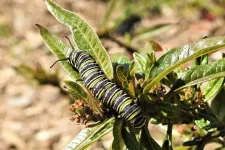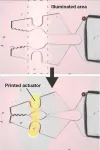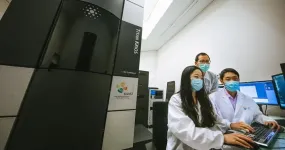(Press-News.org) PULLMAN, Wash. -- A count of the Western Monarch butterfly population last winter saw a staggering drop in numbers, but there are hopeful signs the beautiful pollinators are adapting to a changing climate and ecology.
The population, counted by citizen scientists at Monarch overwintering locations in southern California, dropped from around 300,000 three years ago to just 1,914 in 2020, leading to an increasing fear of extinction. However, last winter large populations of monarchs were found breeding in the San Francisco and Los Angeles areas. Prior to last winter, it was unusual to find winter breeding by monarchs in those locations.
"There's more to it than just counting overwintering butterflies," said David James, an associate professor in Washington State University's Department of Entomology. "It seems that Monarchs are evolving or adapting, likely to the changing climate, by changing their breeding patterns."
The larger numbers of reported sightings of winter breeding monarchs around the San Francisco Bay area prompted James to write a new commentary article in the journal Animal Migration.
The only way to count breeding populations last winter was to look at online citizen scientist observations, supported by limited field work, James said.
"There has been a huge increase in caterpillars in the Bay area, indicating that those populations are breeding," he said. "The data are limited and preliminary, but we think the population is at least double what has been reported. However, it's hard to tell since they're dispersed over much of California."
Past becomes present
James said this pattern of Monarch butterflies adapting looks familiar to him because he saw something similar while working on his Ph.D. dissertation over 40 years ago in Sydney, Australia.
In the late 1970s, the Monarch population in Australia saw huge declines. Scientists thought it was due to habitat loss, a common guess at one factor causing population declines in the western U.S. now.
"In Australia, Monarchs haven't gone extinct," James said. "They've just adapted and moved along with a smaller population. And there's no effort to preserve them there because they aren't a native species. They're just very resilient."
Sunnier outlook
Though the declining population is a concern, James believes Monarchs in the western U.S. will experience a similar plateau and not go extinct.
"San Francisco is very similar, climate-wise, to the area around Sydney," James said. "And seeing this winter breeding, which is something new we saw in Australia in the late 1970s, leads me to think that Monarchs will adapt well to the changing climate in the western US."
He is now working with citizen scientists to collect more data on winter breeding in California that can show this evolution and adaptability.
"The Monarch is like the cockroach of butterflies," James said. "It's very persistent and adaptable all around the world. The population decline is very worrying, but I remain optimistic that it will persist in the western US, although maybe at lower levels than before."
Why Monarchs matter
Monarchs are iconic and very popular, basically the poster insect when anyone thinks about butterflies. Their large orange wings with black accents are immediately recognizable. They're also important pollinators all along their migration routes, which in the western U.S. is basically from the Pacific Northwest to southern California. The loss of habitat for their favored milkweed is one reason for their dramatic population decline.
"Beyond their beauty is their role in ecology," James said. "They pollinate and they are also an important part of the food chain. There's a whole range of reasons why people care about them and don't want them to go extinct."
James is continuing his long-running Monarch tagging program, in which the butterflies are raised and tagged by people in the Northwest, including inmates at a prison, then released so they can migrate south for winter. He thinks he'll find more tagged monarchs around the Bay area in breeding, instead of in non-breeding overwintering colonies, as happened last winter.
He plans to work with citizen scientists to collect and crunch the data to come to solid scientific conclusions. Until then, he maintains his optimism about how well these butterflies adapt.
"We don't know if this adaptation will continue and how successful it will be," James said. "The western Monarch population is quite precarious right now. It's at a tipping point, and something is happening. We need to do more work to find out exactly what is happening."
INFORMATION:
The idea of deriving health benefits from live microorganisms is well known, but some non-living microorganisms, too, can have beneficial health effects. Yet even with an increasing number of scientific papers published on non-viable microbes for health, the category is not well defined and different terms are used in different contexts.
Now, a group of international experts has clarified this concept in a recently END ...
A study published in Cretaceous Research expands the paleontological richness of continental fossils of the Lower Cretaceous with the discovery of a new water plant (charophytes), the species Mesochara dobrogeica. The study also identifies a new variety of carophytes from the Clavator genus (in particular, Clavator ampullaceus var. latibracteatus) and reveals a set of paleobiographical data from the Cretaceous much richer than other continental records such as dinosaurs'.
Among the authors of the study are Josep Sanjuan, Alba Vicente, Jordi Pérez-Cano and Carles Martín-Closas, members of the Faculty of Earth Sciences and the Biodiversity Research Institute (IRBio) of the University of Barcelona, in collaboration with the expert Marius Stoica, ...
Ishikawa, Japan - Inside our cells, and those of the most well-known lifeforms, exist a variety of complex compounds known as "molecular motors." These biological machines are essential for various types of movement in living systems, from the microscopic rearrangement or transport of proteins within a single cell to the macroscopic contraction of muscle tissues. At the crossroads between robotics and nanotechnology, a goal that is highly sought after is finding ways to leverage the action of these tiny molecular motors to perform more sizeable tasks in a controllable manner. However, achieving this goal will certainly be challenging. "So far, even though researchers ...
Singapore, 5 May 2021 - The rapid advancement of Autonomous Vehicles (AV) technology in recent years has changed transport systems and consumer habits globally. As countries worldwide see a surge in AV usage, the rise of shared Autonomous Mobility on Demand (AMoD) service is likely to be next on the cards. Public Transit (PT), a critical component of urban transportation, will inevitably be impacted by the upcoming influx of AMoD and the question remains unanswered on whether AMoD would co-exist with or threaten the PT system.
Researchers at the Future Urban Mobility (FM) Interdisciplinary Research Group (IRG) at Singapore-MIT Alliance for Research and Technology (SMART), MIT's research enterprise in Singapore, and Massachusetts ...
The inner workings of a "self-destruct switch" present on human cells that can be activated during an immune response have been revealed. In unprecedented detail, KAUST scientists with collaborators in China report the 3D atomic structure of the human PANX1 protein, which may help underpin new therapies that target the immune system.
When cells become infected with a pathogen, the body's immune system works to destroy the infected cells before they become a threat to surrounding tissues. This form of cell death, during which a cell releases potent ...
The first civilisations to build monumental palaces and urban centres in Europe are more genetically homogenous than expected, according to the first study to sequence whole genomes gathered from ancient archaeological sites around the Aegean Sea. The study has been published in the journal Cell.
Despite marked differences in burial customs, architecture, and art, the Minoan civilization in Crete, the Helladic civilization in mainland Greece and the Cycladic civilization in the Cycladic islands in the middle of the Aegean Sea, were genetically similar during the Early Bronze age ...
We live in times when among the most limited and precious resources on Earth are air and water. No matter the geographical location, the pollution spreads quickly, negatively affecting even the purest regions like Mount Everest. Thus, anthropogenic activity decreases the quality of the environment, making it harmful for flora and fauna. Current waste treatment methods are not sufficient, so novel and effective methods for maximizing pollutants removal are highly needed. One of the robust and prosperous solutions that make it possible to degrade various highly toxic chemicals from air and water is based on nanotechnology. Nanomaterials offer unique physicochemical properties, ...
Coral are not completely defenceless against attacking juvenile crown of thorns starfish and can fight back to inflict at times lethal damage, new research has found.
This occurs during a period of the crown of thorns starfish life cycle, where small juveniles shift from a vegetarian diet of algae to coral prey. But this change in diet makes the juveniles more vulnerable to attack by coral.
Population outbreaks of adult crown of thorns starfish, alongside coral bleaching is one of the greatest threats to tropical reef habitats.
Video footage shows when the tube feet (small tube-like projections on the underside of a starfish's arm used for movement) of juvenile crown ...
Patients suffering a heart attack received percutaneous coronary intervention (PCI), a procedure to clear blocked arteries in the heart, an average of 10 minutes faster after clinicians and paramedics began using an app to facilitate efficient hospital intakes for these patients, according to a study being presented at the American College of Cardiology's 70th Annual Scientific Session.
The study was conducted at Baystate Medical Center, a health system headquartered in Springfield, Massachusetts, that, like many U.S. hospitals, serves patients across a wide ...
Black patients from disadvantaged neighborhoods were significantly more likely to die within five years of surviving a heart attack compared with Black heart attack patients from wealthier neighborhoods and white patients of any socioeconomic means who survive a heart attack, according to a study being presented at the American College of Cardiology's 70th Annual Scientific Session.
The researchers analyzed data from nearly 32,000 patients with health insurance treated for a heart attack within the Kaiser Permanente Southern California hospital system between 2006-2016. The researchers assigned each ...






